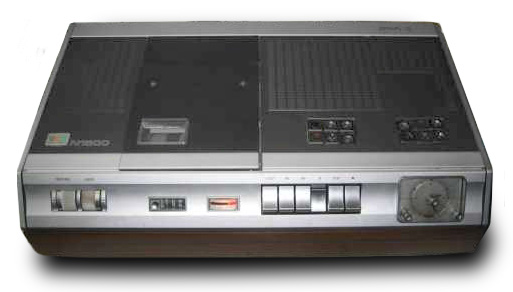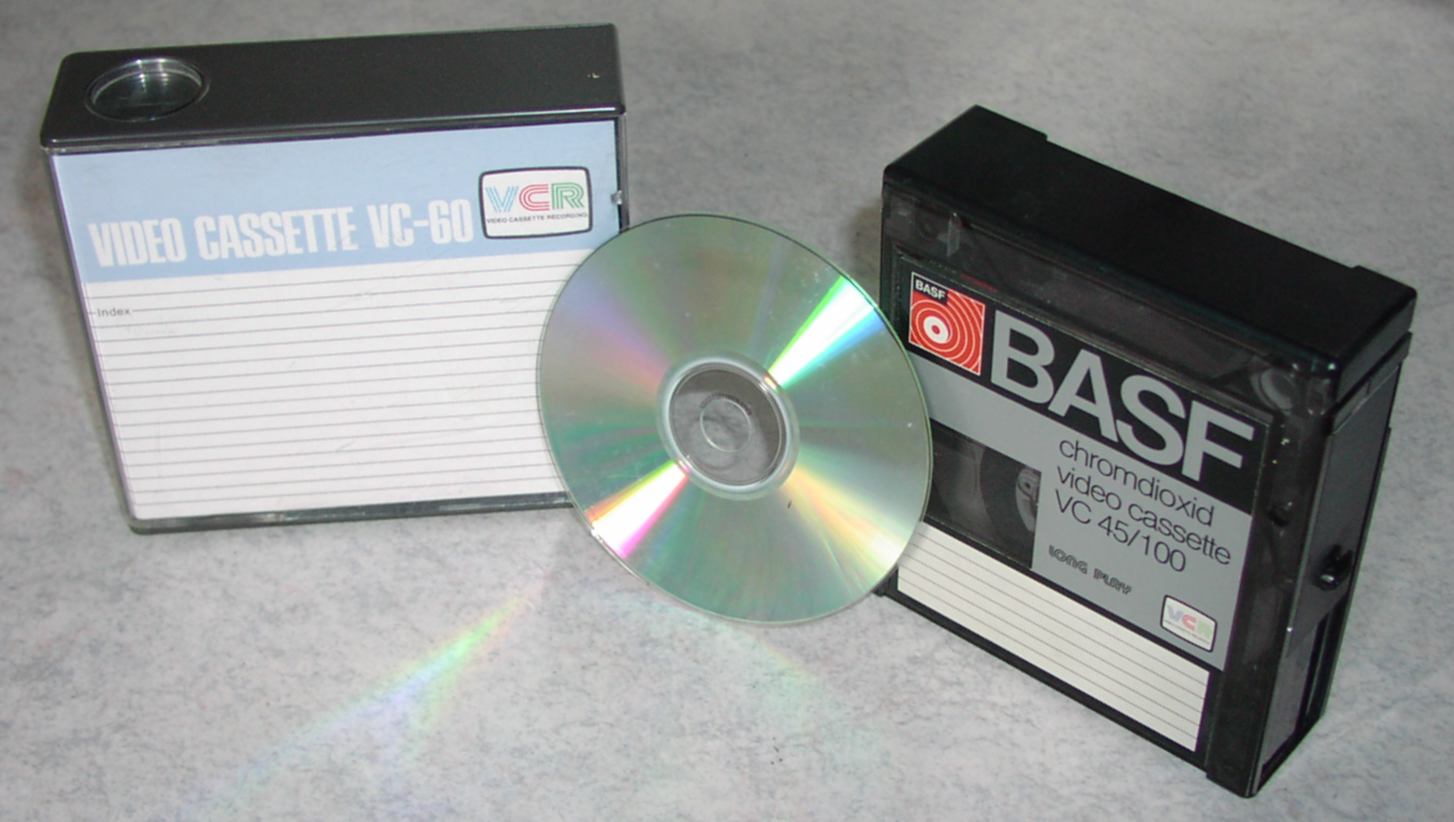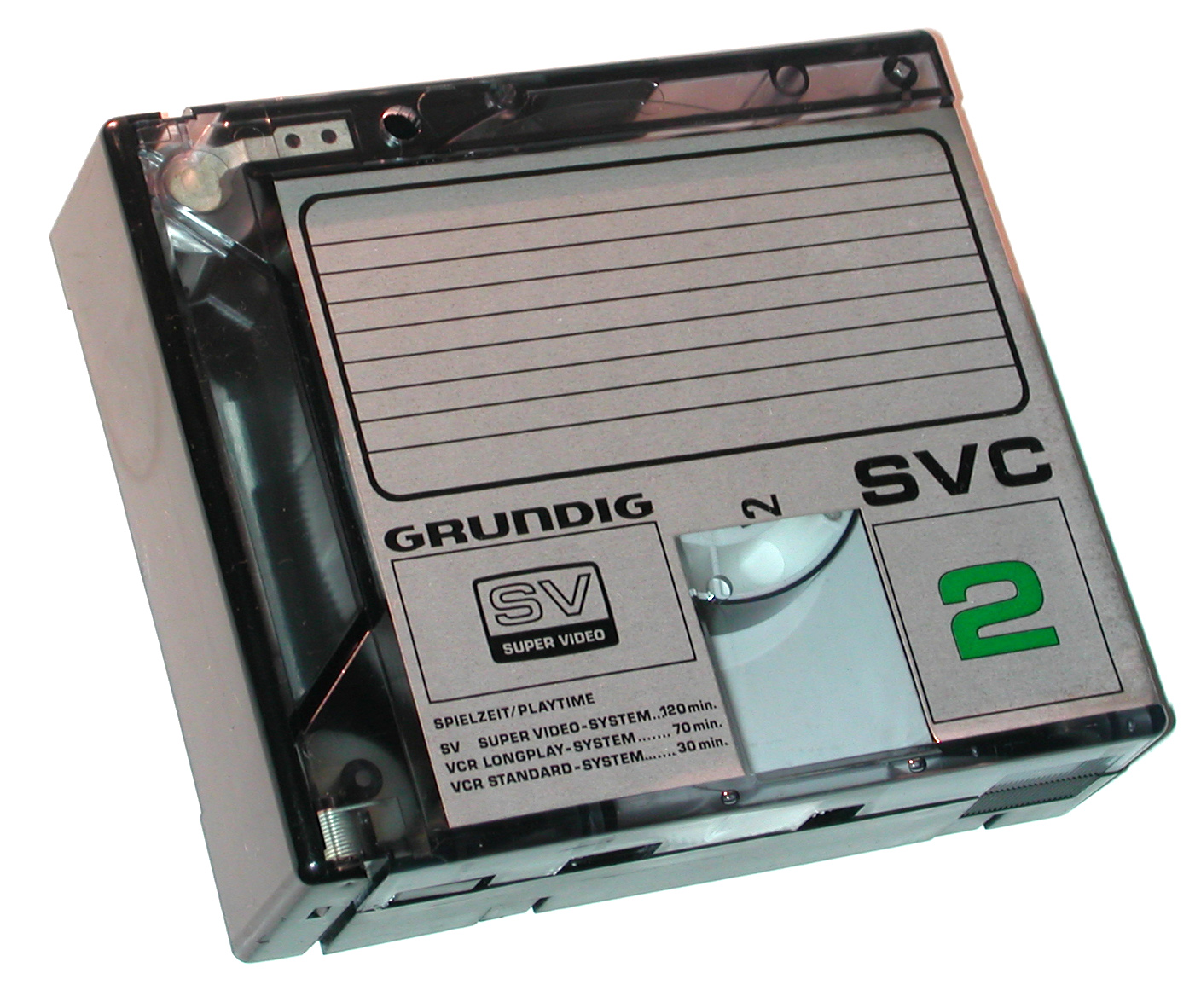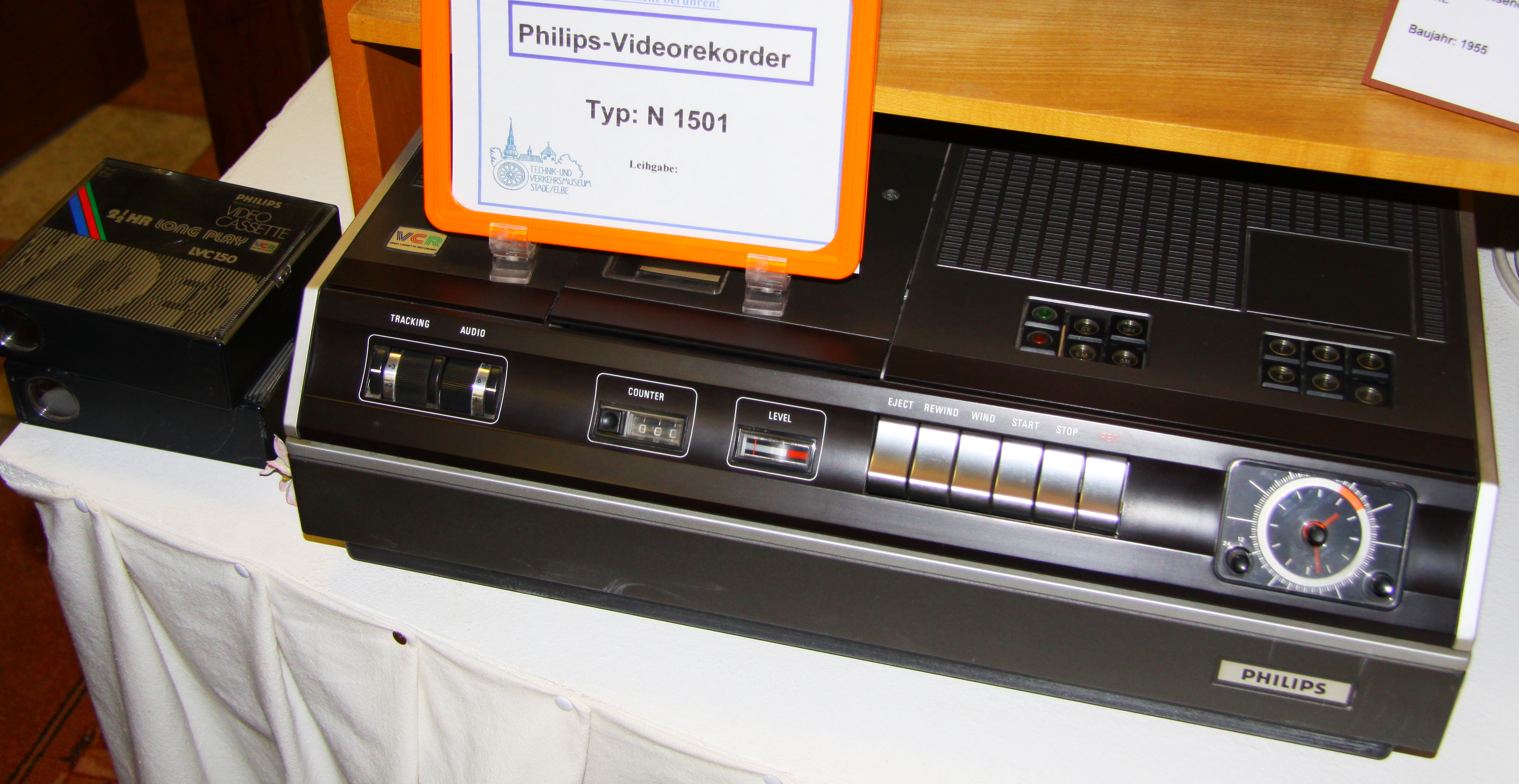Video Cassette Recording on:
[Wikipedia]
[Google]
[Amazon]
 Video Cassette Recording (VCR) is an early domestic analog recording format designed by
Video Cassette Recording (VCR) is an early domestic analog recording format designed by  The VCR format used large square cassettes with 2 co-axial reels, one on top of the other, containing half inch (12.7 mm) wide chrome dioxide
The VCR format used large square cassettes with 2 co-axial reels, one on top of the other, containing half inch (12.7 mm) wide chrome dioxide

 VCR later evolved into a related format known as VCR-LP. This exploited slant azimuth to greatly increase the recording time. Although both formats used identical VCR cassettes, the recordings were incompatible between the two systems, and few if any dual-format recorders existed. Philips N1700, released in 1977, supported the VCR-LP format.
A later even longer-playing variant, Super Video (SVR) was manufactured by Grundig exclusively. SVR was designed to exclusively use
VCR later evolved into a related format known as VCR-LP. This exploited slant azimuth to greatly increase the recording time. Although both formats used identical VCR cassettes, the recordings were incompatible between the two systems, and few if any dual-format recorders existed. Philips N1700, released in 1977, supported the VCR-LP format.
A later even longer-playing variant, Super Video (SVR) was manufactured by Grundig exclusively. SVR was designed to exclusively use

* ) LVC 180 was not recommended for use in a standard VCR machine due to a thin tape base.
** ) VC and LVC cassettes do not work in a SVR machine. However, SVC cassettes may be used in VCR and VCR-LP machines.
 AC Mains present all over the place inside: mains motors, mains clock etc. Slightly improved colour circuitry compared to the original N1500, also modified field blanking to reduce flyback interference on some televisions. Cosmetic variations on the N1500, with black replacing the silver frontage and black plastic surround rather than wood.
AC Mains present all over the place inside: mains motors, mains clock etc. Slightly improved colour circuitry compared to the original N1500, also modified field blanking to reduce flyback interference on some televisions. Cosmetic variations on the N1500, with black replacing the silver frontage and black plastic surround rather than wood.
Total Rewind - The Virtual Museum of Vintage VCRsYahoo group dedicated to N1500, N1700 and SVR format machinesDetailed look at N1500, N1700 and SVR format tapes and machines on YouTubeVideo Cassette Recording (VCR)
an
Video Cassette Recording Long-Play (VCR-LP)
at the Museum of Obsolete Media {{Video storage formats Videotape Discontinued media formats Audiovisual introductions in 1972 1979 disestablishments in the Netherlands 1972 establishments in the Netherlands
 Video Cassette Recording (VCR) is an early domestic analog recording format designed by
Video Cassette Recording (VCR) is an early domestic analog recording format designed by Philips
Koninklijke Philips N.V. (), commonly shortened to Philips, is a Dutch multinational conglomerate corporation that was founded in Eindhoven in 1891. Since 1997, it has been mostly headquartered in Amsterdam, though the Benelux headquarters is ...
. It was the first successful consumer-level home videocassette recorder
A videocassette recorder (VCR) or video recorder is an electromechanical device that records analog audio and analog video from broadcast television or other source on a removable, magnetic tape videocassette, and can play back the reco ...
(VCR) system. Later variants included the VCR-LP and Super Video (SVR) formats.
The VCR format was introduced in 1972, just after the Sony
, commonly stylized as SONY, is a Japanese multinational conglomerate corporation headquartered in Minato, Tokyo, Japan. As a major technology company, it operates as one of the world's largest manufacturers of consumer and professional ...
U-matic
U-matic is an analogue recording videocassette format first shown by Sony in prototype in October 1969, and introduced to the market in September 1971. It was among the first video formats to contain the videotape inside a cassette, as opp ...
format in 1971. Although at first glance the two might appear to have been competing formats, they were aimed at very different markets. After failing as a consumer format, U-matic was marketed as a professional television production
A television show – or simply TV show – is any content produced for viewing on a television set which can be broadcast via over-the-air, satellite, or cable, excluding breaking news, advertisements, or trailers that are typically placed be ...
format, whilst VCR was targeted particularly at educational but also domestic users. Unlike some other early formats such as Cartrivision
Cartrivision is an analog videocassette format introduced in 1972, and the first format to offer feature films for consumer rental.Skip field
In video, skip field recording is a process in which only one field (one half of a frame) of video is recorded in order to conserve recording media space. For some kinds of recording, the quality loss of not using both fields of video is fairly ne ...
.
Home video systems had previously been available, but they were open-reel systems (such as the Sony CV-2000
CV-2000 was one of the world's first home video tape recorders (VTR), introduced by Sony in August, 1965. The 'CV' in the model name stood for 'Consumer Video'. This was Sony's domestic format throughout the 1960s. It was the first fully transis ...
) and were expensive to both buy and operate. They were also unreliable and often only recorded in black and white such as the EIAJ-1. The VCR system was easy to use and recorded in colour but was still expensive: when it was introduced in 1972 the N1500 recorder cost nearly £600 (). By comparison, a small car (the Morris Mini) could be purchased for just over £600.
 The VCR format used large square cassettes with 2 co-axial reels, one on top of the other, containing half inch (12.7 mm) wide chrome dioxide
The VCR format used large square cassettes with 2 co-axial reels, one on top of the other, containing half inch (12.7 mm) wide chrome dioxide magnetic tape
Magnetic tape is a medium for magnetic storage made of a thin, magnetizable coating on a long, narrow strip of plastic film. It was developed in Germany in 1928, based on the earlier magnetic wire recording from Denmark. Devices that use magnet ...
. Three playing times were available: 30, 45 and 60 minutes. The 60-minute videocassette
Videotape is magnetic tape used for storing video and usually sound in addition. Information stored can be in the form of either an analog or digital signal. Videotape is used in both video tape recorders (VTRs) and, more commonly, videocasset ...
s proved very unreliable, suffering numerous snags and breakages due to the very thin 17μm video tape. Tapes of 45 minutes or less contained 20 μm thickness tape. The mechanically complicated recorders themselves also proved somewhat unreliable. One particularly common failing occurred should tape slack develop within the cassette; the tape from the top (takeup) spool may droop into the path of the bottom (supply) spool and become entangled in it if rewind was selected. The cassette would then completely jam and require dismantling to clear the problem, and the tape would then be creased and damaged.
The system predated the development of the slant azimuth technique to prevent crosstalk between adjacent video tracks, so it had to use an unrecorded guard band between tracks. This required the system to run at a high tape speed of 11.26 inches per second.
The Philips VCR system brought together many advances in video recording technology to produce the first truly practical home video cassette system. The very first Philips N1500 model included all the essential elements of a domestic video cassette recorder:
* Simple loading of cassette and simple operation using "Piano Key" controls, with full auto-stop at tape ends.
* A tuner for recording off-air television programmes.
* A clock with timer for unattended recordings.
* A modulator to allow connection to a normal (for the time) television receiver without audio and video input connectors.
The Philips VCR system was marketed only in the U.K., mainland Europe, Australia and South Africa. In mid-1977, Philips announced they were considering distribution of the format in North America, and it was test marketed for several months. Because the format was initially designed only for use with the 625-line 50 Hz PAL system, VCR units had to be modified in order to work with the 60 Hz NTSC
The first American standard for analog television broadcast was developed by National Television System Committee (NTSC)National Television System Committee (1951–1953), Report and Reports of Panel No. 11, 11-A, 12–19, with Some supplement ...
system. Unfortunately, for mechanical and electronic reasons, the tape speed had to be increased by 20%, which resulted in a 60-minute PAL tape running for 50 minutes in a NTSC machine. DuPont announced a thinner videotape formulation that would allow a 60-minute NTSC VCR tape (and roughly 70 minutes in PAL), but the tape was even less reliable than previous formulations. Ultimately, Philips abandoned any hope of trying to sell their VCR format in North America, partly because of the reliability issues, and partly because of the introduction of VHS that same year.
Variants

 VCR later evolved into a related format known as VCR-LP. This exploited slant azimuth to greatly increase the recording time. Although both formats used identical VCR cassettes, the recordings were incompatible between the two systems, and few if any dual-format recorders existed. Philips N1700, released in 1977, supported the VCR-LP format.
A later even longer-playing variant, Super Video (SVR) was manufactured by Grundig exclusively. SVR was designed to exclusively use
VCR later evolved into a related format known as VCR-LP. This exploited slant azimuth to greatly increase the recording time. Although both formats used identical VCR cassettes, the recordings were incompatible between the two systems, and few if any dual-format recorders existed. Philips N1700, released in 1977, supported the VCR-LP format.
A later even longer-playing variant, Super Video (SVR) was manufactured by Grundig exclusively. SVR was designed to exclusively use BASF
BASF SE () is a German multinational chemical company and the largest chemical producer in the world. Its headquarters is located in Ludwigshafen, Germany.
The BASF Group comprises subsidiaries and joint ventures in more than 80 countries ...
- and Agfa-manufactured chrome-dioxide tape in cassettes that were identical to the earlier Philips ones, with the exception of a small actuator added to the bottom of the cassette. This meant that only the BASF/Agfa tapes would work in SVR machines, but that such tapes could also be used in the older VCR and VCR-LP machines. Just as VCR-LP recordings are incompatible with VCR, so SVR recordings are incompatible with both VCR and VCR-LP. The only model to be built was the Grundig SVR4004, with a few detail variations such as optional audio/video connectors, plus a rebadged ITT 240.
Cassette playing times
This chart provides an overview of playing times (in minutes) for the most common cassettes released for standard VCR, VCR-LP and SVR. VC cassettes were originally developed for standard VCR. LVC cassettes were developed for VCR-LP, but are physically identical to VC cassettes. SVC cassettes were specifically developed for SVR.
Models
N1500 (1972)
The first Philips machine was model number N1500, after which the format is also known. This had "first generation" mechanics including magnetic braking servo systems applied to relatively large mains voltage induction motors. The outer edge of the cabinet was wooden. The power cable was detachable, but used an obscure connector for which replacements are not readily available. The N1520 was a N1500 without TV tuner and timer, but with editing functions assemble and insert (using four video heads), 2 track linear audio (not stereo but independent mono channels) and direct AV in/out connections.N1460 (Released 1973)
Often found in schools and colleges where a few master VCR recorders made off-air recordings and the cheaper N1460s were used for playback. In Poland, a slightly modified version was made under the name Unitra magnetowid kasetowy MTV-20.N1501 (Released 1974)
 AC Mains present all over the place inside: mains motors, mains clock etc. Slightly improved colour circuitry compared to the original N1500, also modified field blanking to reduce flyback interference on some televisions. Cosmetic variations on the N1500, with black replacing the silver frontage and black plastic surround rather than wood.
AC Mains present all over the place inside: mains motors, mains clock etc. Slightly improved colour circuitry compared to the original N1500, also modified field blanking to reduce flyback interference on some televisions. Cosmetic variations on the N1500, with black replacing the silver frontage and black plastic surround rather than wood.
N1502 (Released 1976)
The later model N1502 had a totally different mechanism using DC motors and more advanced electronics, and was somewhat more reliable. A later version again was still called N1502 but had further significant mechanical and electronic advances, and in particular had a worm drive for operation of the loading mechanism rather than a fragile plastic gearbox assembly. Earlier machines had a hardwired mains cable, later ones were fitted with a standard "Figure-8" C7 power socket.N1512 (Released 1976)
The N1512 model offered composite video input and output connectors, but was otherwise the same as the N1502. The VCR-LP model N1700 was closely related to the later N1502 variant. Other, rarer Philips models included stereo sound and editing capabilities. Circuitry and internal layout was much more modular than the first generation Philips VCRs. Used quiet DC motors (First generation VCR's used hefty synchronous AC mains motors). Basically this model was the same as the Philips N1502 with an extra board for video in / out. Channel button 8 selected video in.N1700 (Released 1977)
Superficially similar to the Philips N1502 both externally and internally. Some components were interchangeable between the two models. Slower tape-speed and a slant-azimuth recording technique (to almost eliminate cross-talk between video tracks without using tape-wasting guard-bands) made possible the longer playing time without a noticeable loss in picture quality. The mains lead was hard-wired into the machine however later releases of the N1700 had a removable lead - this would become standard on the N1702 model. Also on later models, presumably as the company had already started production of the N1702, the internal Video Head is also sometimes labelled as N1702 instead of N1700. The price in the UK was around £700 which would be over £4000 in 2017. A Skantic branded clone model VCR 1209281 had the silver top design of the later N1702 model.Denis Norden
Denis Mostyn Norden (6 February 1922 – 19 September 2018) was an English comedy writer and television presenter. After an early career working in cinemas, he began scriptwriting during the Second World War. From 1948 to 1959, he co-wrote the ...
promoted this model in the industrial video "The Philips Time Machine".
N1702 (Released 1979)
Similar to the Philips model N1700, the N1702 had a lighter coloured top cover (N1702 was silver and black whilst the N1700 was grey). A 4-digit counter, a 9-day timer, separate mains lead (not hardwired in), and a test-pattern generator to aid TV tuning. Tape transport legends in slightly different position on later N1702's.Grundig models
Grundig built a VCR4000 VCR-LP model which had microprocessor control and so treated the tapes more gently than the purely mechanical decks, and the SVR4004 (longer running SVR format) model was very similar. Other Grundig models included the VCR3000 (believed to be VCR format) and VCR5000AV (believed to be the only dual format VCR and VCR-LP machine).Replacement
In the late 1970s, the VCR formats were superseded altogether byVideo 2000
Video 2000 (also known as V2000, with the tape standard Video Compact Cassette, or VCC) is a consumer videocassette system and analogue recording standard developed by Philips and Grundig to compete with JVC's VHS and Sony's Betamax video tech ...
(also known as 'Video Compact Cassette' or VCC). Due to the similar initialisms
An acronym is a word or name formed from the initial components of a longer name or phrase. Acronyms are usually formed from the initial letters of words, as in ''NATO'' (''North Atlantic Treaty Organization''), but sometimes use syllables, as ...
, and the fact that both were designed by Philips, the 'VCC' and 'VCR' formats are often confused. However, the two systems are incompatible, and there are significant differences between them. Some Video 2000 machines carry a modified version of the "VCR" logo,
''(Advert clickable for full-scale scan showing use of modified "VCR" logo)'' (such as had appeared on the N1500 and N1700http://www.betamax-video.de/bilder/systeme/vcr/n1700%20uhr.jpg machines), adding further to this confusion.
References
External links
Total Rewind - The Virtual Museum of Vintage VCRs
an
Video Cassette Recording Long-Play (VCR-LP)
at the Museum of Obsolete Media {{Video storage formats Videotape Discontinued media formats Audiovisual introductions in 1972 1979 disestablishments in the Netherlands 1972 establishments in the Netherlands